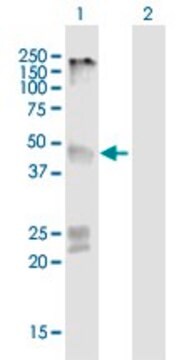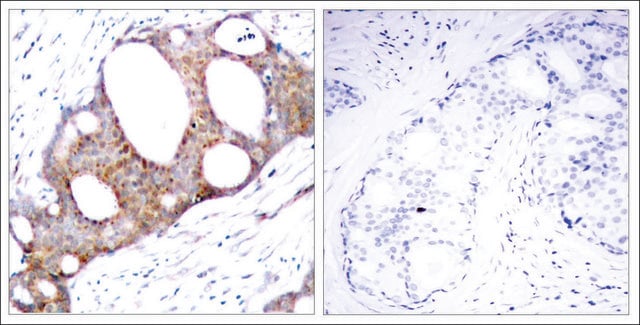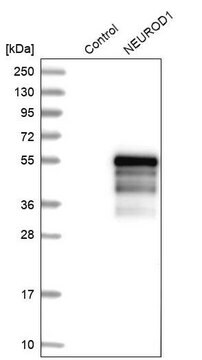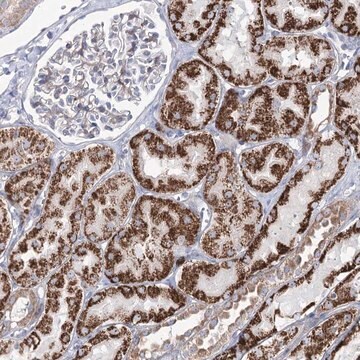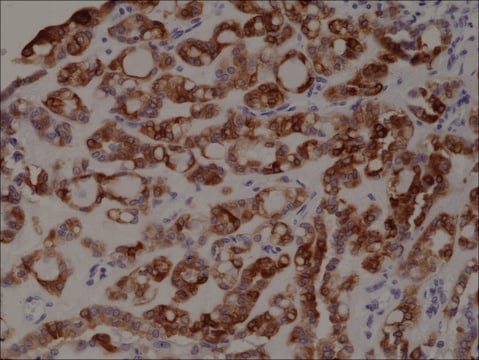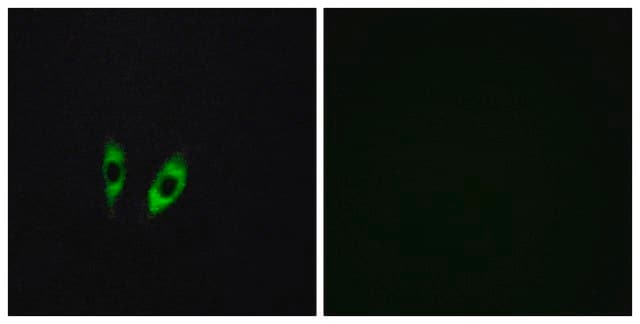おすすめの製品
由来生物
rabbit
結合体
unconjugated
抗体製品の状態
affinity isolated antibody
抗体製品タイプ
primary antibodies
クローン
polyclonal
形状
buffered aqueous solution
分子量
antigen 46 kDa
化学種の反応性
rat, human, mouse
濃度
~1 mg/mL
テクニック
ELISA: 1:1000
immunofluorescence: 1:100-1:500
western blot: 1:500-1:1000
NCBIアクセッション番号
輸送温度
wet ice
保管温度
−20°C
ターゲットの翻訳後修飾
unmodified
遺伝子情報
human ... GPR151(134391)
詳細
G protein-coupled receptor 151 (GPR151) is encoded by the gene mapped to human chromosome 5. It belongs to the A type of G protein-coupled receptor (GPCR) family and it shows homology with galanin receptor 2 and 3. In mice, GPR151 transcript is highly and specifically expressed in habenular neurons.
免疫原
The antiserum was produced against synthesized peptide derived from human GPR151.
Immunogen Range: 370-419
Immunogen Range: 370-419
アプリケーション
Anti-GPR151, C-Terminal antibody produced in rabbit has been used for Western blotting.
生物化学的/生理学的作用
G protein-coupled receptor 151 (GPR151) is a highly conserved protein, and acts as a potential target for psychiatric drug development, due to its expression in habenular neurons which may be critically involved in the pathophysiology of psychiatric disorders such as addiction and depression. Experimental studies reveal that GPR151 might play a neuroprotective and/or pro-regenerative role in the dorsal root ganglion (DRG) after nerve injury.
特徴および利点
Evaluate our antibodies with complete peace of mind. If the antibody does not perform in your application, we will issue a full credit or replacement antibody. Learn more.
物理的形状
ウサギIgGのPBS溶液(Mg2+およびCa2+を含まず)、pH 7.4、150 mM NaCl、0.02% アジ化ナトリウム、50% グリセロール
免責事項
Unless otherwise stated in our catalog or other company documentation accompanying the product(s), our products are intended for research use only and are not to be used for any other purpose, which includes but is not limited to, unauthorized commercial uses, in vitro diagnostic uses, ex vivo or in vivo therapeutic uses or any type of consumption or application to humans or animals.
Not finding the right product?
Try our 製品選択ツール.
保管分類コード
12 - Non Combustible Liquids
WGK
nwg
引火点(°F)
Not applicable
引火点(℃)
Not applicable
適用法令
試験研究用途を考慮した関連法令を主に挙げております。化学物質以外については、一部の情報のみ提供しています。 製品を安全かつ合法的に使用することは、使用者の義務です。最新情報により修正される場合があります。WEBの反映には時間を要することがあるため、適宜SDSをご参照ください。
Jan Code
SAB4500418-100UG:
試験成績書(COA)
製品のロット番号・バッチ番号を入力して、試験成績書(COA) を検索できます。ロット番号・バッチ番号は、製品ラベルに「Lot」または「Batch」に続いて記載されています。
Conserved expression of the GPR151 receptor in habenular axonal projections of vertebrates.
Broms J, et al.
The Journal of Comparative Neurology, 523(3), 359-380 (2015)
Nisa Roy et al.
Scientific reports, 11(1), 5549-5549 (2021-03-12)
G-protein coupled receptor 139 (GPR139) is an evolutionarily conserved orphan receptor, predominantly expressing in the habenula of vertebrate species. The habenula has recently been implicated in aversive response and its associated learning. Here, we tested the hypothesis that GPR139 signalling
Yuxiao Yao et al.
Molecular neurobiology (2023-07-21)
Histamine receptors mediate important physiological processes and take part in the pathophysiology of different brain disorders. Histamine receptor 1 (HRH1) is involved in the development of neurotransmitter systems, and its role in neurogenesis has been proposed. Altered HRH1 binding and
Targeted disruption of the orphan receptor Gpr151 does not alter pain-related behaviour despite a strong induction in dorsal root ganglion expression in a model of neuropathic pain.
Holmes FE, et al.
Molecular and Cellular Neurosciences, 78, 35-40 (2017)
Glenn Morton et al.
The Journal of neuroscience : the official journal of the Society for Neuroscience, 38(31), 6900-6920 (2018-06-30)
Genetic studies have shown an association between smoking and variation at the CHRNA5/A3/B4 gene locus encoding the α5, α3, and β4 nicotinic receptor subunits. The α5 receptor has been specifically implicated because smoking-associated haplotypes contain a coding variant in the
ライフサイエンス、有機合成、材料科学、クロマトグラフィー、分析など、あらゆる分野の研究に経験のあるメンバーがおります。.
製品に関するお問い合わせはこちら(テクニカルサービス)
